Failover vs. Failback: Two Disaster Recovery Methods
A key distinction in the realm of disaster recovery is 关键字3the one between failover and failback. Both terms describe two sides of the same coin, complementary processes that are often brought together. However, their effects and purposes couldn't be more different. Both play critical roles in ensuring business continuity and disaster recovery, making it essential to understand what they are and how they differ. Failover is a business continuity operation that ensures continued access to a system by fully transitioning to another instance of that system. This secondary system is designed to be resilient, ideally unaffected by the event that compromised the primary system. Put simply, failover occurs when connectivity is switched from one system instance to another. This can happen in various ways, including: Editor's Note: The critical point about failover is that it involves a complete migration of logical or physical access from the primary system, server, or hosting location to a secondary one. While other processes, such as load balancing, may distribute partial connectivity between system instances or components, they do not qualify as failover because they do not represent a full cutover. Failback is the quintessential disaster recovery operation. It involves a full migration back to the production status quo – a recovery if you will – at the validated conclusion of a disaster. Failback occurs when a system reverts back to the primary environment after the root cause of a disruption has been addressed. In practice, this looks like a failover, but in reverse. Once the primary system is restored, access is pointed to that system, and the standby is deactivated. This reversion is a critical distinction. Some organizations may have complete standby systems for critical applications, which permit full operations on the standby system. In that case, the standby can rightfully be considered the primary and the repaired former primary the new standby. Failover is critical in a business continuity event because it keeps operations running. By having a system to which your business can transition when a primary system is unavailable, you're able to continue doing business. People can work, revenue streams are preserved, and customers can be served. Without failover, these functions could grind to a halt, leading to significant disruption. Many organizations depend on technology for critical processes, and when those processes are unavailable, analog alternatives may be insufficient or entirely obsolete. Failover ensures that even in a disaster, the business keeps moving. Failback comes into play once the need for failover ends. As the disaster is resolved, failback allows the organization to return to normal operations. Typically, failback is necessary when the standby system cannot sustain operations as effectively as the primary system. For instance, a standby system may not be a full replica of the primary system and might be designed only for temporary use during an emergency. For mission-critical systems, some organizations may build a standby system that is a full replica of the primary. While costly, this approach mitigates the risks of diminished functionality during disasters. In an ideal world, every business would maintain two fully operational environments: a primary environment and an identical standby environment. This setup would allow for seamless transitions during disasters, ensuring that business operations are completely unaffected. However, that model can effectively double an IT budget: two sets of endpoints, two sets of servers, two sets of cloud environments, two sets of data, staff to support that both in IT and business operations, etc. It's costly and inefficient for any company, to the point where no company truly maintains that support model. Instead, most organizations opt for a failover and failback model because it balances cost and efficiency. With this approach, the standby environment is designed to sustain critical operations during a disaster, even if it's not as robust as the primary system. This makes it more economical, less work is duplicated, and the risk of data loss or impact is lower. It's crucial to maintain a well-designed secondary environment. Cutting costs too deeply on a standby system can result in inefficiencies or financial losses if critical operations are disrupted. Striking the right balance between cost and functionality is key. If uninterrupted business operations are essential, then a strategic failover and failback plan is not optional – it's a necessity.What is Failover?

This guest blog post was written by the staff at Pure Storage, an US-based publicly traded tech company dedicated to enterprise all-flash data storage solutions. Pure Storage keeps a very active blog, this is one of their "Purely Educational" posts that we are reprinting here with their permission.What is Failback?

The Role of Failover and Failback in Disaster Recovery

The Benefits of Leveraging Both Failover and Failback

-
上一篇
-
下一篇
- 最近发表
-
- DSI รวบหัวหน้าแอดมินเว็บพนันเครือข่ายแม่มนต์ฝากขังศาลอาญา ค้านประกันตัว
- 高晓松前妻承认与张子萱前夫恋情 自曝在英语班相识
- สถานทูตไทยแจงวีซ่าคนไทยเข้ากัมพูชาทางเครื่องบิน อยู่ได้ไม่เกิน 60 วัน
- สภาพอากาศกรุงเทพฯ ทุ่มนี้ ไม่มีกลุ่มฝน อุณหภูมิ 31 องศาฯ
- DSI รวบหัวหน้าแอดมินเว็บพนันเครือข่ายแม่มนต์ฝากขังศาลอาญา ค้านประกันตัว
- 农业部新批准进口5种农业转基因生物 包括大豆、玉米、油菜等
- 国家防总启动防汛四级应急响应 派工作组赴广西协助指导
- “河港杯”第三届全国陆地风帆车公开赛收官
- 双色球1现象时隔952天再现 7110万大奖皆因它?
- 传奇私服侵权案侦破,游戏行业应加强著作权意
- 随机阅读
-
- 2025高中语文名著必读 值得推荐的有哪些
- 《共鸣:瘟疫传说传承》发布预告片 2026年发售
- 传奇战士:金钱与力量的结合体
- 15 Places to Find Fairies
- Display Tech Comparison: IPS vs. VA vs. TN vs. QD
- 颂党恩,迎国庆,垃圾分类在行动
- 火焰纹章圣战系谱24斩乱数怎么判定
- 北欧风装修贵不贵 如何装修北欧风格
- 中国最有智慧的古书 2025谋略奇书推荐
- 期末评语简短20字左右(精选4篇)
- 13 Places You Have to Hear
- 圣火徽章外传我方角色成长率(%)是多少
- 玩游戏需留意帐号平安
- Drop Into the Game: Netflix Squid Game Comes to Call of Duty
- 韦东奕账号应该注销,真正还他以宁静
- 大火锅!足彩头奖爆2.1万注677元 单注历史第10低
- 《狂野星球复仇记》玩家数量破百万 主创谈订阅制服务与未来计划
- dnf手游65版本搬砖图推荐 65级版本搬碳还刷布万加吗
- “垃圾分类从我做起.践行文明用餐光盘新风尚”
- 13 Places You Have to Hear
- 搜索
-
- 友情链接
-